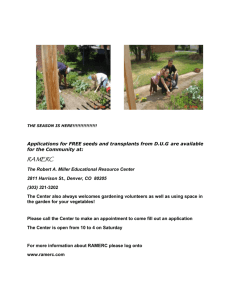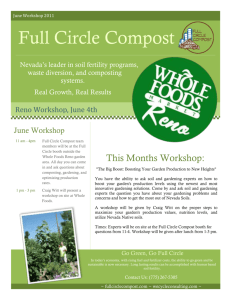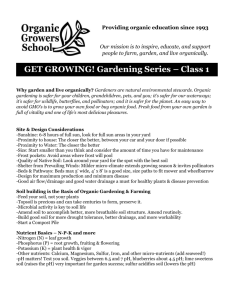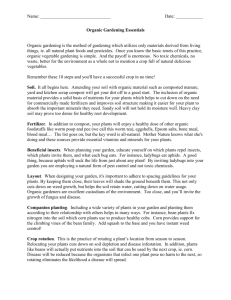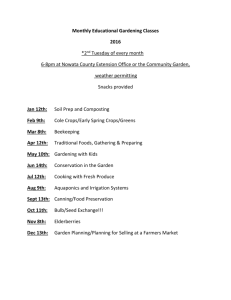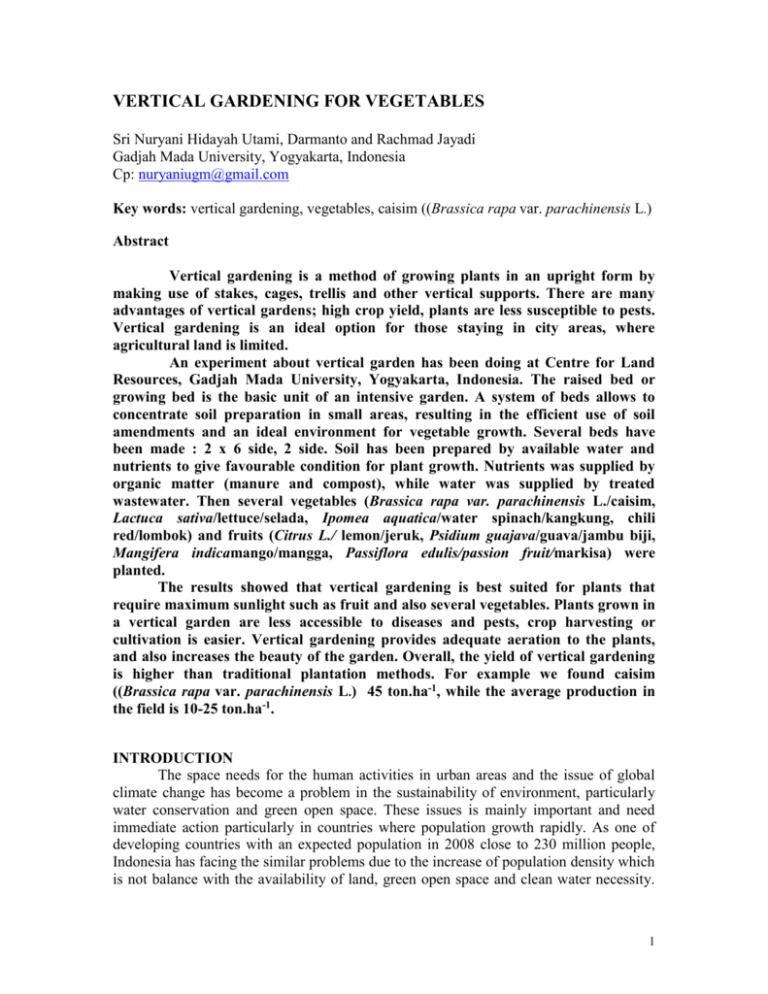
VERTICAL GARDENING FOR VEGETABLES
Sri Nuryani Hidayah Utami, Darmanto and Rachmad Jayadi
Gadjah Mada University, Yogyakarta, Indonesia
Cp: nuryaniugm@gmail.com
Key words: vertical gardening, vegetables, caisim ((Brassica rapa var. parachinensis L.)
Abstract
Vertical gardening is a method of growing plants in an upright form by
making use of stakes, cages, trellis and other vertical supports. There are many
advantages of vertical gardens; high crop yield, plants are less susceptible to pests.
Vertical gardening is an ideal option for those staying in city areas, where
agricultural land is limited.
An experiment about vertical garden has been doing at Centre for Land
Resources, Gadjah Mada University, Yogyakarta, Indonesia. The raised bed or
growing bed is the basic unit of an intensive garden. A system of beds allows to
concentrate soil preparation in small areas, resulting in the efficient use of soil
amendments and an ideal environment for vegetable growth. Several beds have
been made : 2 x 6 side, 2 side. Soil has been prepared by available water and
nutrients to give favourable condition for plant growth. Nutrients was supplied by
organic matter (manure and compost), while water was supplied by treated
wastewater. Then several vegetables (Brassica rapa var. parachinensis L./caisim,
Lactuca sativa/lettuce/selada, Ipomea aquatica/water spinach/kangkung, chili
red/lombok) and fruits (Citrus L./ lemon/jeruk, Psidium guajava/guava/jambu biji,
Mangifera indicamango/mangga, Passiflora edulis/passion fruit/markisa) were
planted.
The results showed that vertical gardening is best suited for plants that
require maximum sunlight such as fruit and also several vegetables. Plants grown in
a vertical garden are less accessible to diseases and pests, crop harvesting or
cultivation is easier. Vertical gardening provides adequate aeration to the plants,
and also increases the beauty of the garden. Overall, the yield of vertical gardening
is higher than traditional plantation methods. For example we found caisim
((Brassica rapa var. parachinensis L.) 45 ton.ha-1, while the average production in
the field is 10-25 ton.ha-1.
INTRODUCTION
The space needs for the human activities in urban areas and the issue of global
climate change has become a problem in the sustainability of environment, particularly
water conservation and green open space. These issues is mainly important and need
immediate action particularly in countries where population growth rapidly. As one of
developing countries with an expected population in 2008 close to 230 million people,
Indonesia has facing the similar problems due to the increase of population density which
is not balance with the availability of land, green open space and clean water necessity.
1
The annual population growth rate in 2007 was 1.45% and the 2007 GDP per capita was
USD 1,947. The emerging Indonesian middle class and a high level of urbanization have
triggered a rapidly growing property sector in major cities like Jakarta, Surabaya,
Bandung, Yogyakarta, Bali, Medan and Makassar putting pressure on the space needed,
as well as water supply and sanitation services. Urban areas in Indonesia need
comprehensive solution to control those issues without neglecting the sustainability of
ecosystem and environment in where they live. Vertical gardening is a method of
growing plants in an upright form by making use of stakes, cages, trellis and other
vertical supports. There are many advantages of vertical gardens; high crop yield, plants
are less susceptible to pests. Vertical gardening is an ideal option for those staying in city
areas, where agricultural land is limited (Nitisapto, 1993; Damastuti, 1996). The
objectives of this works were to reduce the wastewater that being disposed to the
environment; create and reduce as vice versa the space needed for wastewater treatment
plant in urban areas and to produce several vegetables in a small space.
MATERIAL AND METHODS
Several beds have been made : 2 x 6 side, 2 side. Soil (Entisols) has been prepared
by available water and nutrients to give favourable condition for plant growth. Nutrients
was supplied by organic matter (manure and compost), while water was supplied by
treated sewage sludge. Then several vegetables (cabbage/caisim, lettuce/selada,
ipomea/kangkung, chilli red/lombok) and fruit (lemon/jeruk, guava/jambu biji,
mango/mangga and markisa) were planted.Domestic wastewater is pumped to the top of
building using solar cell energy. Two units of slow-sand filter which is installed on the
top of building are operated to filtering the wastewater. The treated water thus is used to
irrigate the roof garden plants. The water quality parameters has been analyzed including
pH, TDS, DHL, COD, BOD, Fe, and Mn.
RESULTS AND DISCUSSION
The purpose of gardening intensively is to harvest the most produce possible from
a given space. An intensive garden minimizes wasted space. The practice of intensive
gardening is not just for those with limited garden space; rather, an intensive garden
concentrates efforts to create an ideal plant environment, giving better yields. A vertical
vegetable garden is easy to plan and build. Several vegetables were planted (lettuce,
cabbage, leek, cauliflower, chilli red, but we focus only for cabbage.
Wastewater treatment quality
Table 1 showed the mean quality of wastewater after treatment. The water pH was
good enough, about 7,5 – 7,7. The wastewater recycling installation increasing
wastewater quality through slow sand filter. Slow sand filter significantly decreased total
density (tds), Carbon Oxygen Demand (COD), Biochemical Oxygen Demand (BOD) and
Fe, and also Mnn. Figure 1 and 2 showed BOD and Fe of wastewater before and after
treatments.
To determine the effectiveness of domestic waste water treatment performance, we
calculated the efficiency of total water quality recovery. The data showed that domestic
wastewater treatment of downflow was 97,6; 89,5; 76,5; and 75,5% respectively for total
solut, COD, BOD and Fe, while in upflow was 98,9%; 82,9%; 64,5% and 73,5%
2
respectively for total soluble), COD, BOD and Fe. Result of the analysis of water effluent
showed that the quality water effluent is increase about 40% to 90% after filtered.
Effluent discharged from the filters is suitable to be used as irrigation water for the
vertical garden plants.
.Vegetables production
Total biomass was of caisim was harvested at 28 days and separated into shoots
and roots. There was no significantly differences in fresh and dry biomass weight among
the level of bed. The fresh and dry biomass of caisim of the top ed (1rst) till the lowest
seedbed (6th) are almost the same, but the data showed that the top and the lowest tends to
have lower weight. Biomass production is primarily driven by photosynthesis, while
photosynthesis to a great extent depends on light interception, which furtheremore varies
with leaf area of the canopy (Dorais, 2003), but caisim was adapted to cool temperature
(16 – 20 oC) and moist climates (Wichmann, 2002). The second till fifth seedbed gave
cool and moist climate, but the top seedbed was hotter than the other seedbeds, while in
the lowest seedbed was poor sunlight. While some plant species are capable of
flourishing with modest quantities of sunlight, it is a fact that most vegetables require
plenty of sunlight to reach their potential. This means that an ideal location for growing
vegetables receives sunlight for most of the day, without the encumbrance of overhanging
tree branches, hedges or shrubbery.
Soil quality after vertical gardening
Many interrelated factors influence soil productivity (Havlin et al. (2005), but soil
organic matter content is the most critical, because its influence on many biological,
chemical, and physical characteristics inherent in a productive soil. The steady-state
organic matter level depends on soil and crop management practice influencing C
accumulation and loss. Tables 5. showed that the soil quality after farming is good
enough. The greatest source of soil organic matter is the residue contributed by crops, but
also from the manure addition. Table 4. showed the quality of poultry manure which was
added to the soil. The poultry manure contain relatively low concentrations of N, P, and
K. They typically decompose slowly and behave as a slow-release source of N over many
months or years since the rapidly decomposable compounds have been previously
degraded during the composting process. The organic N-containing compounds in
manure become available for plant uptake following mineralization by soil
microorganisms, while the inorganic N fraction is immediately available.
The soil quality after poultry manure application was better, especially for the pH,
cation eexchange capacity, organic matter content and total N. The soil reaction (pH) has
a direct and indirect nutritional effect on plant growth. In the range of 6.0 to 7.0, nearly
all plant are available in optimal amounts. The C:N ratio of the organic material added to
the soil influences the rate of decomposition of organic matter and this results in the
release (mineralisation) or immobilization of soil nitrogen. If the added organic material
contains more nitrogen in proportion to the carbon, then nitrogen is released into the soil
from the decomposing organic material. On the other and, if the organic material has a
less amount of nitrogen in relation to the carbon then the microorganisms will utilize the
soil nitrogen for further decomposition and the soil nitrogen will be immobilized and will
not be available. The key to building healthy soil is organic matter management. Building
3
up and maintaining soil organic matter contributes to nutrient management through better
soil tilth and thus root exploration, enhanced biological activity which increases
mineralization and nutrient availability, and greater cation exchange capacity which
enhances nutrient retention. Soil organic matter also promotes an abundance of
microorganisms that can stimulate root growth and help solubilize nutrients.
The other vegetables which have been harvesting were cabbage, water spinach,
leek, lettuce and chilli red (Table 6.).
The biomass productivity of vegetables (g/plant) by verticulture were still below
the average yield in the field, especially for water spinach, leek, cabbage, but because by
vertical gardening we have a lot of plants so the productivity of vegetables (ton/ha) were
always higher than the productivity in the field. The problem were the quantity of the
soil as crops medium and also the sunlight. Cabbage as Cruciferous vegetables grow well
without much sunlight. If there is a lot of sunlight, then they will not grow well. Lettuce
and water spinach are green leaves vegetables which means vegetables that grow in
shade. The only difference between the leaves grown with and without sunlight is in the
thickness of leaf. Leafy vegetable that grow in the shade is slightly thinner but has the
same taste. Based on the research, only the small trunked vegetables were able to grow
equally as vegetables growed in the field, such as caisim and lettuce.
The result showed that one of the major advantages of vertical gardening is
harvesting maximum products in a minimum space. Following are some of the benefits of
vertical gardening: 1) Some of the highly spreading plants can be grown effectively in a
vertical garden, 2) Vertical gardening is best suited for plants that require maximum
sunlight, 3). Plants grown in a vertical garden are less accessible to diseases and pests, 4)
Easy access to ripe vegetables; hence crop harvesting or cultivation is easier, 5) Vertical
gardening provides adequate aeration to the plants, AND 6) Vertical gardening increases
the beauty of the garden. Nitisapto (1993) reported water saving by vertical gardening
with 1 column was three times because water only used for transpiration and little for
evaporation.
CONSLUSION
The purpose of vertical gardening intensively is to harvest the most produce
possible from a given space. An intensive garden minimizes wasted space. The practice
of intensive gardening is not just for those with limited garden space; rather, an intensive
garden concentrates efforts to create an ideal plant environment, giving better yields. A
vertical vegetable garden is easy to plan and build. Vertical gardening for vegetables
provides many benefits including: Save space, easier to harvest, better air circulation,
keeps vegetables off the ground and better yields.
ACKNOWLEDGEMENT.
Thanks to Ministry of National Education, Republic Indonesia (Directorate of
Research and Service for the Community) for financial support.
4
LITERATURE CITED
Damastuti, A. 1996. Vertical agriculture system. (In Indonesian). Wacana No. 3/JuliAgustus 1996.
Dorais, M. 2003. The use of supplemental lighting for vegetable crp production: light
intensity, crop response, nutrition, crop management, cultural practices. Canadian
Greenhouse Conferences, October 9, 2003.Inetpub/wwwroot/greenhouse/2007
Havlin, J.L, S.L. Tisdale, J.D. Beaton, and W.L. Nelson. 2005. Soil Fertility and
Fertilizers. An Introduction to Nutrient Management. Seventh edition. Pearson
Prentice Hall, Upper Saddle River, New Jersey.
Nitisapto, M. 1993. Vegetables cropping with Vertical Agriculture. Faculty of
Agriculture, Universitas Gadja Mada Yogyakarta. (In Indonesian.)
Wichmann, W.1992. World Fertilizer use manual. IFA. Paris, France.
TABLES:
Table 1. Quality of wastewater before and after treatments
Parameter
pH
DHL
(μS/cm)
TDS (mg/l)
Turbidity
(NTU)
COD
(mg/l)
BOD
(mg/l)
Mn (mg/l)
Fe (mg/l)
Wastewater/
selokan
7,50
300
Well/
Sumur 3
7,69
359
Location
Inlet slow-sand
filtered
7,65
304
143
7,68
140
2,87
145
2,51
145
0,18
145
0,08
12,58
7,84
9,23
1,32
2,15
3,32
3,29
2,81
1,18
0,78
0,06
0,98
0,12
0,61
0,07
0,46
0,04
0,24
0,02
0,26
Outlet
Downflow
7,64
302
Outlet
Upflow
7,56
302
5
Table 2. Total efficency recovery of wastewater treatment
Parameter
Total
soluble
COD
BOD
Fe
Eficiency (%)
Downflow
Upflow
97,6
98,9
89,5
76,5
75,5
82,9
64,5
73,5
Table 3. Fresh and dry biomass weight
Number of seedbed
Fresh biomass weight (g)
Dry biomass weight (g)
I
185.66a
18.15a
II
240.12a
21.09a
III
302.64a
20.55a
IV
194.5a
24.31a
V
184.4a
14.52a
VI
178a
24.89a
Numbers in each column by common letters are not significantly at 5% Duncan’s multiple range test
Table 4. The quality of poultry manure
Parameter
Water content (%)
pH H2O
EC mS/ cm
Organic C (%)
Total N (%)
Total P (%)
Total K (%)
CEC cmol(+)kg-1
Value
8.2
7.92
41.3
45.15
1.22
0.37
3.12
51.07
6
Tabel. 5. Soil quality after vertical gardening
Number of
seedbed
pH
Organic
Total N
C
%
%
Control *)
6.50
2.09
0.06
I
7.30
4.43
0.33
II
7.32
3.77
0.33
III
7.65
3.61
0.28
IV
7.22
3.78
0.27
V
7.43
3.78
0.31
VI
7.23
3.77
0.32
*) the soil (Entisols) before treated with manure
C/N
13.2
11.42
12.89
14.0
12.78
11.78
Cation Exchange
capacity cmol(+)kg-1
7.87
13.48
13.71
14.37
13.54
15.18
15.80
Table 6. The yield of vegetables by vertical gardening
vegetables
Mean
weight g/
plant
Mean
weight
kg/4 m2
weight
kg/ha
yield
tones ha-1
Ipomea (Ipomoea
aquatica)
leek (Allium
ampeloprasum var.
porrum (L.)
Caisim/Cabbage
(Brassica oleracea
L)
Lettuce (Lactuca
sativa)
Chilli red
(Capsicum Annum)
40.62
3.65
9139.5
9.13
Average
yield tones
ha-1 in the
field
6.65
143.25
8.595
21487.5
21.48
10.51
309.6
18.57
46440
46.44
19.97
131.26
3.15
7876
7.87
9.62
916.5
3.66
9165
9.16
11.3
7
FIGURES.
Figure 1. BOD of wastewater before and after treatments
Figure 2. Fe concentration in wastewater before and after treatment.
8

